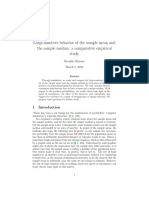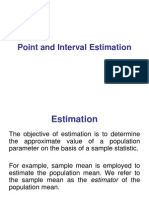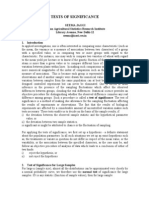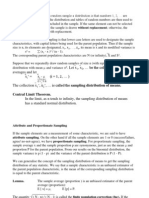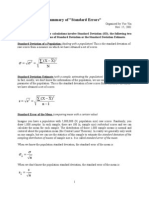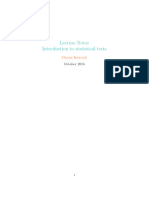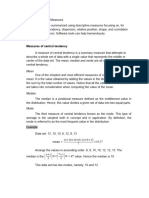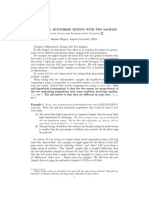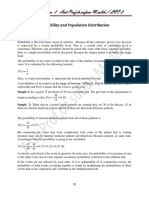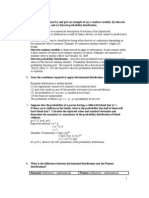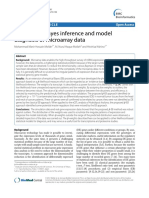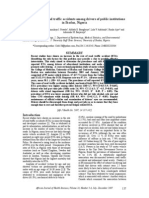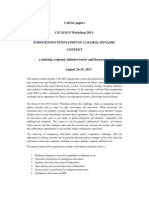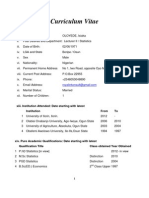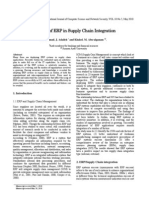11411
11411
Uploaded by
oloyede_wole3741Copyright:
Available Formats
11411
11411
Uploaded by
oloyede_wole3741Copyright
Available Formats
Share this document
Did you find this document useful?
Is this content inappropriate?
Copyright:
Available Formats
11411
11411
Uploaded by
oloyede_wole3741Copyright:
Available Formats
Electronic Journal of Applied Statistical Analysis EJASA (2013), Electron. J. App. Stat. Anal., Vol.
6, Issue 1, 110 117 e-ISSN 2070-5948, DOI 10.1285/i20705948v6n1p110 2013 Universit del Salento http://siba-ese.unile.it/index.php/ejasa/index
ON THE EXPECTED DIFFERENCE BETWEEN MEAN AND MEDIAN Robin de Nijs*, Thomas Levin Klausen
Department of Clinical Physiology, Nuclear Medicine and PET, Rigshospitalet, Copenhagen University Hospital, Copenhagen, Denmark Received 19 August 2011; Accepted 31 May 2012 Available online 26 April 2013
Abstract: Mean and median are both estimators of the central value of statistical distributions. For a given sampled continuous probability distribution function the equations for the influence of one sample are used to derive the known expressions for the standard deviation of mean and median and the novel expression for the expectation value of the squared differerence between mean and median. The usefulness of this result is illustrated on a dataset, where the difference between mean and median serves as an outlier detection and as a tool for deciding whether to use the mean or median as an estimator. Keywords: Mean, median, standard deviation, efficiency, expectation, outlier.
1.
Introduction
Both mean (average) and median are commonly used as estimators for the true value of a sampled quantity. The uncertainty of these estimators is given by their standard deviation (SD). For normal distributions the SD of the mean is lower than the SD of the median. This means that in this case the mean is a better estimator in terms of uncertainty. On the other hand, if outliers are present, the SD of the mean may become very large, while the SD of the median remains more or less the same. In the case of an outlier the mean itself is potentially changed drastically, while the median remains close to the central value of the original statistical distribution. These are well-known properties of the mean and median, and it is said, that the median is a more robust estimator of the central value. The question, that remains, is what the numerical difference between mean and median is for a given dataset. In this note an equation for the (squared) expected difference between mean and median is derived and it is shown how this can be used as a tool for analyzing a dataset.
*
Email: robin.de.nijs@rh.regionh.dk
110
de Nijs, R., Klausen, T.L. (2013). Electron. J. App. Stat. Anal., Vol. 6, Issue 1, 110 117.
2.
Materials and Methods
SD is a measure for the uncertainty or statistical noise. The SD of the mean x is just the SD of the population divided by the square root of the number of samples. The symbol s will be used to indicate the empirical SD of a set of samples, while the symbol will be used for the SD of a continuous probability distribution. The SD of the median can be approximated with [1, 3]:
2 s 2 (x) s 2 (~ x) = n
1 , 4np 2 ( ~ x)
(1)
where n is the number of samples, p the underlying continuous probability density function, ~ x the median, and a constant depending on the number of samples and related to the relative efficiency of the median (=-2). The (asymptotic) approximation holds for large n, but the exact values of the efficiency can be calculated, see Table 1 and 2. For instance, the underestimation of the variance of the median is less than 10 %, and consequently less than 5 % for , for n>4 for normal distributions and odd values of n [8]. The asymptotic efficiency is 2 1.25 for normal distributions with width , which have p 1 ( ~ x ) = 2 and n s 2 ( x ) = 2 . For uniform distributions with width d the asymptotic value is = 3 1.73 with p( ~ x ) = d 1 and n s 2 ( x ) = d 2 12 . This means that for these distributions the uncertainty in the median is bigger than in the mean. For symmetric (non-skewed) distributions the expectation value of mean and median is the same. So there should be no difference between these two apart from uncertainty. However, this changes when so-called outliers are added to the dataset. The median minimizes the total absolute deviation, while the mean minimizes the total squared deviation. This means that the median is less sensitive (more robust) to outliers, but on the other hand has a larger uncertainty in the absence of outliers. 2.1 The influence of one sample The difference between mean and median is nicely illustrated by the influence of one sample xi of a data set with n samples and mean x . The mean is shifted (shift is indicated by ) by:
x i =
x i x x i . n n
(2)
The influence of one sample depends both on the number of samples and the sample value. For a large number of samples n and an assumed underlying continuous probability distribution function p(x) the shift in the median ~ x caused by one sample of the dataset can be calculated by sampling the underlying continuous probability distribution function (pdf) around the median in such a way that the area under the pdf with width w corresponds to one sample. This means that the integral of the continuous pdf around the median times the number of samples equals one. The width w is equal to the sampling distance yielding a sampling density of one around the median. This corresponds to that the median is shifted half a position in the ordered list of samples. The shift in the median is then given by:
111
On the expected difference between mean and median
1 w , ~ xi = 2 2np ( ~ x)
(3)
and shifted in the opposite direction for samples with a value lower than the median. Alternatively equation (3) can be derived by the analysis of the influence of one sample on the cumulative probability distribution. The median is defined by the value of x where the cumulative continuous distribution function D is 1/2, which states that exactly half of the samples have a lower value than the median, see e.g. p.45 [2]. The influence of one sample on the value of D is 1 2n . This gives the possibility to approximate the influence of one sample on the median for large n with:
dD ( ~ x) ~ 1 x dx 2n
~ x=
1 , 2np ( ~ x)
(4)
where the derivative of the cumulative probability distribution is replaced by the probability density function. The shift in the median does not depend on the value of the extra sample, which is an appealing property in the case of an outlier. Only the position of the median in the ordered list of samples is shifted half a position. In the case of an even number of outliers equally added above and below the true median value the shift is even cancelled. The probability function of the median itself is normally distributed for any probability function of the samples. Equation (2) and (3) can be used for calculation of the standard deviations of mean and median. The standard deviation of the mean s( x ) for a set of samples given by:
s 2 ( x ) = (xi ) 2 =
i
< (x) 2 > s 2 , = n n
(5)
and the standard deviation of the median s ( ~ x )
for a set of samples is given by:
2 ~ 2 s 2 (~ x) = 2 n s ( x ) = ( x i ) i
1 , 4np 2 ( ~ x)
(6)
which is equivalent to equation (1). 2.2 The expected difference between mean and median Because the median and mean are strongly correlated, the expected squared difference is not just the sum of their variances (var=SD2). The expected squared difference of mean and median is given by:
< (x ~ x ) 2 >=< x ~ x > 2 + var( x ~ x ) =< x ~ x > 2 + var( x ) + var(~ x ) 2 cov( x , ~ x ).
(7)
112
de Nijs, R., Klausen, T.L. (2013). Electron. J. App. Stat. Anal., Vol. 6, Issue 1, 110 117.
1,2
1,0
0,8
odd even odd even asymptotic
0,6
0,4
0,2
0,0 1 3 5 7 9 11 13 15 17 19 21 23 25
Figure 1. Values for and as a function of the number of samples for a normal distribution.
The variances of mean and median are given by equations (5) and (6). The covariance cov( x , ~ x ) between mean and median can be calculated for a set of samples with:
cov( x , ~ x ) = x i ~ xi
i
< x> , 2np ( ~ x)
(8)
where xi and ~ xi are defined and approximated with the asymptotic value by equations (2) and (3). For distributions with the same expectation value for mean and median the expectation value of the squared difference between mean and median for a set of samples is given by:
2 x ) 2 >= n xi ) 2 s 2 ( x ) + < (x ~ s 2 ( x ) = (x i ~ i
< x> 1 , 2 ~ x) 4np ( x ) np ( ~
(9)
where is a constant related to the relative efficiency. Here the variance is replaced by the squared SD of the dataset. For normal distributions is 2 1 0.76 and for uniform distributions equals one. So the expectation value of the squared difference between mean and median is of the order of the variance of the mean for both normal and uniform distributions. 113
On the expected difference between mean and median
1,8 1,6 1,4 1,2 odd 1,0 0,8 0,6 0,4 0,2 0,0 1 3 5 7 9 11 13 15 17 19 21 23 25 even odd even asymptotic
Figure 2. Values for and as a function of the number of samples for a uniform distribution.
From Chebyshevs inequality it can be derived that the difference between mean and median of a continuous probability density function is less than the standard deviation of the underlying distribution [4]. This imposes an upper bound of n on 2. The values and are calculated as a function of n for a normal distribution in Table 1 and a uniform distribution in Table 2 with a statistical simulation performed in Matlab 7.9, The Mathworks Inc., Natick, Massachusetts, USA. Figure 1 and 2 show the results from Table 1 and 2 in a graph. In a given dataset the SD of the median and the expectation value of the squared difference between mean and median might be approximated by assuming a certain statistical distribution, calculating the standard deviation of the mean and applying the appropriate value for and . The calculated value of the expectation value of the squared difference between mean and median can be compared with the observed difference between mean and median and statistically tested. Assuming a normal distribution of the difference between mean and median the null-hypothesis (no outliers) can be tested with a so-called Z-test, yielding a p-value indicating the statistical significance. An alternative statistical test for the detection of outliers could be the chi squared test. In this test the observed variance is compared to the known expected variance. Since the variance in general is not known beforehand this test cannot be applied here.
114
de Nijs, R., Klausen, T.L. (2013). Electron. J. App. Stat. Anal., Vol. 6, Issue 1, 110 117. Table 1. Values for and for a normal distribution, calculated by statistical simulation. A graph of the values for and can be found in Figure 1. k 2k 2k+1 2k 2k+1 1 2 3 4 5 6 7 8 9 10 50 1.0000 1.0922 1.1351 1.1600 1.1761 1.1875 1.1960 1.2025 1.2077 1.2119 1.2445 1.2533 1.1602 1.1976 1.2137 1.2227 1.2283 1.2322 1.2350 1.2372 1.2390 1.2404 1.2506 1.2533 0.0000 0.4391 0.5371 0.5878 0.6191 0.6404 0.6560 0.6678 0.6771 0.6846 0.7408 0.7555 0.5882 0.6589 0.6878 0.7035 0.7133 0.7200 0.7249 0.7285 0.7314 0.7338 0.7511 0.7555
Table 2. Values for and for a uniform distribution, calculated by statistical simulation. A graph of the values for and can be found in Figure 2. k 2k 2k+1 2k 2k+1 1 1.0000 1.3416 0.0000 0.6325 2 1.2649 1.4638 0.4472 0.7559 3 1.3888 1.5276 0.5976 0.8165 4 1.4606 1.5667 0.6832 0.8528 5 1.5076 1.5933 0.7386 0.8771 6 1.5407 1.6125 0.7774 0.8944 7 1.5653 1.6270 0.8062 0.9075 8 1.5843 1.6384 0.8284 0.9177 9 1.5993 1.6475 0.8460 0.9259 10 1.6116 1.6550 0.8603 0.9325 50 1.7065 1.7152 0.9705 0.9854 1.7321 1.7321 1.0000 1.0000
However, in the case of Poisson statistics the chi squared test might be applied, since in this case the variance is equal to the mean itself.
3.
Results
The calculated values for are in agreement with the values found in literature [5,8,9]. The relative deviation from the asymptotic value of the variance of the median is as expected approximately twice the relative deviation in . For even numbers of n the convergence the asymptotic value is slower to than for odd values. In Figure 3 a histogram is shown of measurements of the specific binding ratio (SBR) for dopamine transporters, measured with Iodine-123 SPECT [6], for healthy subjects and for patients (Parkinson disease) with decreased SBR. Each person has two SBRs; a SBR for the left and right part of the brain. In order to demonstrate the difference between mean and median first the statistics of the healthy subject group are calculated and then the statistics of this group with 1 and 2 patients added. The results are shown in Table 3.
115
On the expected difference between mean and median
Figure 3. A histogram of the specific binding ratio (both of the left and right striatum) for dopamine transporter for five healthy subject and two Parkinson patients.
In the column with 10 samples in Table 3 it can be seen, that the difference between mean and median is of the same order as the SD of the mean. Things change drastically when so-called outliers (the patients in this dataset) are added to the dataset, as illustrated by the last two columns in Table 3.
Table 3. The mean, median, their standard deviations and their difference for the SBR dataset. Each subject has two samples (left and right striatum). The second column with 10 samples shows the data for the 5 healthy subjects. The third column shows the dataset of the second column with one patient (outlier) added, and the last column shows this dataset with two patients (outliers) added. The last two rows show the z- and p-value for the statistical testing of the observed difference between mean and median against the difference according to equation (9) assuming un underlying normal distribution. Number of samples 10 12 14 Mean 10.4 9.0 8.0 Median 10.9 10.6 10.2 SD of the Mean 0.56 1.06 1.10 SD of the Median* 0.70 1.31 1.36 Mean-Median, observed -0.45 -1.61 -2.18 Mean-Median* 0.37 0.71 0.75 z 1.22 2.28 2.91 p# 0.222 0.022 0.004 * estimated with equation (6) and (9) assuming an underlying normal distribution # double sided p-value, assuming the difference between mean and median is normally distributed
The SD of the mean gets bigger, but most profound is, that while the difference between mean and median in the first column was of the same order as the SD of the mean, the difference between mean and median is drastically increased and becomes clearly larger than the
116
de Nijs, R., Klausen, T.L. (2013). Electron. J. App. Stat. Anal., Vol. 6, Issue 1, 110 117.
(empirical) SD of the mean. The calculated p-values indicate that this is statistically significant and that the null-hypothesis (no outliers) needs to be rejected in the last two cases.
4.
Conclusions
Both mean and median as well as their difference are useful tools for characterizing acquired datasets. In practice both mean and median can be calculated, and their difference can reveal unwanted properties of the acquired dataset. Outliers and asymmetrical (skewed) probability distributions will result in a big difference between mean and median. If the difference between mean and median is limited the mean can be used as the least noise sensitive estimator. Mean and median are not only useful for scalar quantities, but also for the analysis of signals [10] and images [7], where mean filtering (averaging) and median filtering can be applied. In this statistical note the known result of the variance of mean and median for large sample sizes is shown, and the novel result for the expectation value of the squared difference between mean and median is derived and presented. This gives an opportunity to investigate datasets by looking at the difference between mean and median and comparing it to the uncertainty in the mean.
References
[1]. Cramr, H. (1946). Mathematical Methods of Statistics. Princeton: Princeton University Press. [2]. Hogg, R.V., Craig, A.T. (1995). Introduction to Mathematical Statistics, 5th ed. New York: Macmillan. [3]. Kenney, J.F., Keeping, E.S. (1962). 13.13 The Median, in Mathematics of Statistics, part 1, 3rd ed. Princeton, NJ: Van Nostrand, 211-212. [4]. Mallows, C.L., Richter, D. (1969). Inequalities of Chebyshev type involving conditional expectations. The Annals of Mathematical Statistics, 40, 1922-1932. [5]. Maritz, J.S., Jarrett, R.G. (1978). A note on estimating the variance of the sample median. Journal of the American Statistical Association, 73, 194-196. [6]. de Nijs, R., Holm, S., Thomsen, G., Ziebell, M., Svarer, C. (2010). Experimental determination of the weighting factor for the energy window subtraction based downscatter correction for I-123 in brain SPECT-studies. Journal of Medical Physics, 35, 215-222. [7]. Pratt, W.K. (1978). 12.6 Median Filter, in Digital Image Processing, New York: John Wiley & Sons Inc., 330-333. [8]. Rider, P.R. (1960). Variance of the median of small samples from several special populations. Journal of the American Statistical Association, 55, 148-150. [9]. Sheather, S.J. (1986). A finite sample estimate of the variance of the sample median. Statistics & Probability Letters, 4, 337-342. [10]. Slotboom, J., Nirkko, A., Brekenfeld, C., van Ormondt, D. (2009). Reliability testing of in vivo magnetic resonance spectroscopy (MRS) signals and signal artifact reduction by order statistic filtering. Measurement Science and Technology, 20, 104030 (14pp).
This paper is an open access article distributed under the terms and conditions of the Creative Commons Attribuzione - Non commerciale - Non opere derivate 3.0 Italia License.
117
You might also like
- Comparing The Areas Under Two or More Correlated Receiver Operating Characteristic Curves A Nonparametric ApproachDocument10 pagesComparing The Areas Under Two or More Correlated Receiver Operating Characteristic Curves A Nonparametric Approachajax_telamonioNo ratings yet
- Assessment Task - Studies of ReligionDocument2 pagesAssessment Task - Studies of Religionapi-554235939No ratings yet
- Harrah's Entertainment, Inc.Document23 pagesHarrah's Entertainment, Inc.RefeerNo ratings yet
- IntroBioInfStatistics - Chapter2.revised 8956517989503105Document28 pagesIntroBioInfStatistics - Chapter2.revised 8956517989503105Edn Ed EddieNo ratings yet
- ML Unit2 SimpleLinearRegression pdf-60-97Document38 pagesML Unit2 SimpleLinearRegression pdf-60-97Deepali KoiralaNo ratings yet
- 1703-02 MarreroDocument14 pages1703-02 MarreroarcegarrojeNo ratings yet
- Point and Interval Estimation-26!08!2011Document28 pagesPoint and Interval Estimation-26!08!2011Syed OvaisNo ratings yet
- Data Notes For IN3Document66 pagesData Notes For IN3Lyse NdifoNo ratings yet
- Standard Deviation - Wikipedia, The Free EncyclopediaDocument12 pagesStandard Deviation - Wikipedia, The Free EncyclopediaManoj BorahNo ratings yet
- MAE 300 TextbookDocument95 pagesMAE 300 Textbookmgerges15No ratings yet
- Application of Statistical Concepts in The Determination of Weight Variation in SamplesDocument6 pagesApplication of Statistical Concepts in The Determination of Weight Variation in SamplesRaffi IsahNo ratings yet
- الفصل الثاني الاحصاءDocument27 pagesالفصل الثاني الاحصاءbifusk481No ratings yet
- Mathematics Statistical Square Root Mean SquaresDocument5 pagesMathematics Statistical Square Root Mean SquaresLaura TaritaNo ratings yet
- Measure VariabilityDocument6 pagesMeasure VariabilityAlexander DacumosNo ratings yet
- Univariate StatisticsDocument4 pagesUnivariate StatisticsDebmalya DuttaNo ratings yet
- Standar DeviasiDocument20 pagesStandar DeviasiÅwink BeêNo ratings yet
- Mathematical Foundations of Computer ScienceDocument24 pagesMathematical Foundations of Computer Sciencemurugesh72No ratings yet
- Counting Statistics: Presented by Vikas LakhwaniDocument21 pagesCounting Statistics: Presented by Vikas LakhwaniRachit KanchanNo ratings yet
- 3-Tests of SignificanceDocument13 pages3-Tests of SignificanceDrGaurav GuptaNo ratings yet
- Measures of DispersionDocument13 pagesMeasures of Dispersionsabnira Afrin100% (1)
- Sampling Theory: Central Limit TheoremDocument4 pagesSampling Theory: Central Limit Theoremj.p.reninNo ratings yet
- Biostatistics For Academic2Document38 pagesBiostatistics For Academic2Semo gh28No ratings yet
- Standard ErrorDocument3 pagesStandard ErrorUmar FarooqNo ratings yet
- Chapter 4Document46 pagesChapter 4Javeria NaseemNo ratings yet
- Small Sample TestsDocument10 pagesSmall Sample TestsJohn CarterNo ratings yet
- Technical Analysis PDFdrive 10Document17 pagesTechnical Analysis PDFdrive 1020mayis20No ratings yet
- VariabilityDocument8 pagesVariabilityJelica VasquezNo ratings yet
- StatisticsDocument18 pagesStatisticsMundu MustafaNo ratings yet
- StatestsDocument20 pagesStatestskebakaone marumoNo ratings yet
- Chapter 4Document8 pagesChapter 4NJeric Ligeralde AresNo ratings yet
- Chi SquareDocument35 pagesChi SquarePravab DhakalNo ratings yet
- Bio Statistics 3Document13 pagesBio Statistics 3Moos LightNo ratings yet
- StatisticalDocument3 pagesStatisticalbondoclance13No ratings yet
- 5.2. Hypothesis Tests and Confidence Intervals One Sample Z-Test and Confidence IntervalDocument6 pages5.2. Hypothesis Tests and Confidence Intervals One Sample Z-Test and Confidence IntervalrpinheirNo ratings yet
- Univariate StatisticsDocument7 pagesUnivariate StatisticsDebmalya DuttaNo ratings yet
- MMW Managing DataDocument3 pagesMMW Managing Datashalala16763118No ratings yet
- Chapter10 StatsDocument7 pagesChapter10 StatsPoonam NaiduNo ratings yet
- Mean, Standard Deviation, and Counting StatisticsDocument2 pagesMean, Standard Deviation, and Counting StatisticsMohamed NaeimNo ratings yet
- Dr. Sufian M. Salih / Probability and Population DistributionDocument6 pagesDr. Sufian M. Salih / Probability and Population Distributiondr.ssufian2006No ratings yet
- Standard Deviation-From WikipediaDocument11 pagesStandard Deviation-From WikipediaahmadNo ratings yet
- Nummerical SummariesDocument11 pagesNummerical Summaries60 Vibha Shree.SNo ratings yet
- Intro BRMDocument11 pagesIntro BRMVTNo ratings yet
- Stats and Prob Reviewer, Q3 Jess Anch.Document8 pagesStats and Prob Reviewer, Q3 Jess Anch.JessicaNo ratings yet
- Basic - Statistics 30 Sep 2013 PDFDocument20 pagesBasic - Statistics 30 Sep 2013 PDFImam Zulkifli S100% (1)
- Lab4_ErrorAnalysisII (1)Document8 pagesLab4_ErrorAnalysisII (1)yugshah180No ratings yet
- CPL Practical 1Document14 pagesCPL Practical 1Saniya BondeNo ratings yet
- 2.2.7 Statistical Tool Employed For Analysis: Percentage MethodDocument6 pages2.2.7 Statistical Tool Employed For Analysis: Percentage MethodBoobalan RNo ratings yet
- ANOVADocument6 pagesANOVAmisganabbbbbbbbbbNo ratings yet
- Measures of Variability- KhyatiDocument40 pagesMeasures of Variability- KhyatiMalay BNo ratings yet
- The R Project For Comparisons of Several Multivariate Means: Chu-Yu Chung Hang Du Yi Su Xiangmin Zhang December 7, 2009Document17 pagesThe R Project For Comparisons of Several Multivariate Means: Chu-Yu Chung Hang Du Yi Su Xiangmin Zhang December 7, 2009Paul Sandoval GutierrezNo ratings yet
- UsingStdNormalDataAnalysisKEO 1107Document3 pagesUsingStdNormalDataAnalysisKEO 1107misterkenoNo ratings yet
- Lecture No.10Document8 pagesLecture No.10Awais RaoNo ratings yet
- Chapter-3ni Kamote ChuaDocument29 pagesChapter-3ni Kamote ChuaBryan GonzalesNo ratings yet
- Normal Distribution-7Document5 pagesNormal Distribution-7Shobha Kumari ChoudharyNo ratings yet
- MeanDocument27 pagesMeanMichelle Marie Duat SabalNo ratings yet
- Statistics ReviewDocument16 pagesStatistics ReviewAlan BatschauerNo ratings yet
- Sampling and Sampling DistributionsDocument2 pagesSampling and Sampling DistributionsrachelNo ratings yet
- 2.C StatisticsDocument5 pages2.C StatisticsMinaz PatelNo ratings yet
- f (x) ≥0, Σf (x) =1. We can describe a discrete probability distribution with a table, graph,Document4 pagesf (x) ≥0, Σf (x) =1. We can describe a discrete probability distribution with a table, graph,missy74No ratings yet
- 2.2 Unit-DspDocument63 pages2.2 Unit-Dspsuryashiva422No ratings yet
- Sample Size for Analytical Surveys, Using a Pretest-Posttest-Comparison-Group DesignFrom EverandSample Size for Analytical Surveys, Using a Pretest-Posttest-Comparison-Group DesignNo ratings yet
- Empirical Bayes Inference and Model Diagnosis of Microarray DataDocument16 pagesEmpirical Bayes Inference and Model Diagnosis of Microarray Dataoloyede_wole3741No ratings yet
- Accident 2Document5 pagesAccident 2oloyede_wole3741No ratings yet
- Steps in Fuzzy Logic EstimationDocument13 pagesSteps in Fuzzy Logic Estimationoloyede_wole3741No ratings yet
- Package Dse1': R Topics DocumentedDocument3 pagesPackage Dse1': R Topics Documentedoloyede_wole3741No ratings yet
- Accidents 1Document6 pagesAccidents 1oloyede_wole3741No ratings yet
- Scientific Computing InstituteDocument1 pageScientific Computing Instituteoloyede_wole3741No ratings yet
- OSRC: The Revolution Within: by Akintayo Abodunrin, TribuneDocument4 pagesOSRC: The Revolution Within: by Akintayo Abodunrin, Tribuneoloyede_wole3741No ratings yet
- 2013 Call Workshop CicalicsDocument3 pages2013 Call Workshop Cicalicsoloyede_wole3741No ratings yet
- Curriculum Vitae: Personal DetailsDocument5 pagesCurriculum Vitae: Personal Detailsoloyede_wole3741No ratings yet
- Vine CopulaDocument85 pagesVine Copulaoloyede_wole3741No ratings yet
- De SolveDocument52 pagesDe Solveoloyede_wole3741No ratings yet
- Nonparametric Test With SPSS: Chi SquareDocument6 pagesNonparametric Test With SPSS: Chi Squareoloyede_wole3741No ratings yet
- For Your Academic Research)Document1 pageFor Your Academic Research)oloyede_wole3741No ratings yet
- PSJLC DELTA Class Vaccination FormatDocument6 pagesPSJLC DELTA Class Vaccination FormatServus DeiNo ratings yet
- Division Action Research FormatDocument16 pagesDivision Action Research FormatedgardoNo ratings yet
- 430 New StudyDocument88 pages430 New Studyjee vellNo ratings yet
- Laboratory Manual in Surveying 1 Fieldwork No. 2: Taping LEARNING OUTCOMES: After Completion The Fieldwork Activity The Students Are Expected ToDocument5 pagesLaboratory Manual in Surveying 1 Fieldwork No. 2: Taping LEARNING OUTCOMES: After Completion The Fieldwork Activity The Students Are Expected ToMau MauNo ratings yet
- Classifying Non-Functional Requirements Using RNNDocument7 pagesClassifying Non-Functional Requirements Using RNNless64014No ratings yet
- Itc ProjectDocument38 pagesItc ProjectanandbittuNo ratings yet
- Impact Assessment in The European Union: Andrea Renda, Senior Research Fellow, CEPSDocument47 pagesImpact Assessment in The European Union: Andrea Renda, Senior Research Fellow, CEPSganadrasNo ratings yet
- Geostatistical Applications in Petroleum Reservoir ModellingDocument5 pagesGeostatistical Applications in Petroleum Reservoir ModellingCris TinaNo ratings yet
- Motivation Letter CottbusDocument3 pagesMotivation Letter CottbusFaizan Osto0% (3)
- Acc 206 Cost Accounting - Lecture NoteDocument71 pagesAcc 206 Cost Accounting - Lecture NoteFolarin EmmanuelNo ratings yet
- New SyllabusDocument5 pagesNew Syllabusharsh2242harshNo ratings yet
- Accounts ISC-17Document47 pagesAccounts ISC-17Ajay Kumar MishraNo ratings yet
- Project C: Dr. Shahin Tavakoli Applied Bayesian Statistics Project 1Document2 pagesProject C: Dr. Shahin Tavakoli Applied Bayesian Statistics Project 1方鑫然No ratings yet
- A Research Paper Presented To The English Faculty of Abellana National School Cebu CityDocument26 pagesA Research Paper Presented To The English Faculty of Abellana National School Cebu CityKathleen Gabrielle RomaNo ratings yet
- Fitriya 2023Document16 pagesFitriya 2023mehedaameliaNo ratings yet
- Atkins 1998Document16 pagesAtkins 1998HocvienMAENo ratings yet
- MATH2801 RevisionDocument303 pagesMATH2801 RevisionJakeNo ratings yet
- Densidad ASTM D4052Document5 pagesDensidad ASTM D4052Coordinador LaboratorioNo ratings yet
- (Ebook PDF) Business Statistics A First Course First Canadian EditionDocument51 pages(Ebook PDF) Business Statistics A First Course First Canadian EditionzisismixoNo ratings yet
- Tata Kelola Inovasi Layanan PublikDocument19 pagesTata Kelola Inovasi Layanan Publikdeksan winotoNo ratings yet
- Unifox: The Benchmark of ExcellenceDocument15 pagesUnifox: The Benchmark of ExcellenceVaibhav UpadhyayNo ratings yet
- JSSC JDLCCE JE Regular VacancyDocument49 pagesJSSC JDLCCE JE Regular Vacancyjoy parimalaNo ratings yet
- Organizing Business Case Competition-Guidelines For Business SchoolsDocument19 pagesOrganizing Business Case Competition-Guidelines For Business SchoolsZamilur Rahman ShuvoNo ratings yet
- chitle projectDocument69 pageschitle projectpraveenNo ratings yet
- The Role of ERP in Supply Chain Integration: Mohammad. J. Adaileh and Khaled. M. Abu-AlganamDocument6 pagesThe Role of ERP in Supply Chain Integration: Mohammad. J. Adaileh and Khaled. M. Abu-AlganamYashwant ShrimaliNo ratings yet
- Sample Thesis SDLCDocument5 pagesSample Thesis SDLCbkx89b3r100% (2)
- PR 2 - Lindog MARCH 2024 (Body)Document42 pagesPR 2 - Lindog MARCH 2024 (Body)villanuevadimple91No ratings yet
- Anwar Syawali FitraDocument15 pagesAnwar Syawali FitraAnwar SyawaliNo ratings yet





